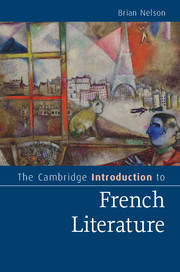Book contents
- Frontmatter
- Dedication
- Contents
- Preface
- Acknowledgements
- Chronology
- 1 Villon: a dying man
- 2 Rabelais: the uses of laughter
- 3 Montaigne: self-portrait
- 4 Corneille: heroes and kings
- 5 Racine: in the labyrinth
- 6 Molière: new forms of comedy
- 7 La Fontaine: the power of fables/fables of power
- 8 Madame de Lafayette: the birth of the modern novel
- 9 Voltaire: the case for tolerance
- 10 Rousseau: man of feeling
- 11 Diderot: the enlightened sceptic
- 12 Laclos: dangerous liaisons
- 13 Stendhal: the pursuit of happiness
- 14 Balzac: ‘All is true’
- 15 Hugo: the divine stenographer
- 16 Baudelaire: the streets of Paris
- 17 Flaubert: the narrator vanishes
- 18 Zola: the poetry of the real
- 19 Huysmans: against nature
- 20 Mallarmé: the magic of words
- 21 Rimbaud: somebody else
- 22 Proust: the self, time and art
- 23 Jarry: the art of provocation
- 24 Apollinaire: impresario of the new
- 25 Breton … Company: Surrealism
- 26 Céline: night journey
- 27 Sartre: writing in the world
- 28 Camus: a moral voice
- 29 Beckett: filling the silence
- 30 French literature into the twenty-first century
- Notes
- Further reading
- Index of authors and titles
- Index of genres, movements and concepts
- Cambridge Introductions to …
- References
7 - La Fontaine: the power of fables/fables of power
Published online by Cambridge University Press: 05 July 2015
- Frontmatter
- Dedication
- Contents
- Preface
- Acknowledgements
- Chronology
- 1 Villon: a dying man
- 2 Rabelais: the uses of laughter
- 3 Montaigne: self-portrait
- 4 Corneille: heroes and kings
- 5 Racine: in the labyrinth
- 6 Molière: new forms of comedy
- 7 La Fontaine: the power of fables/fables of power
- 8 Madame de Lafayette: the birth of the modern novel
- 9 Voltaire: the case for tolerance
- 10 Rousseau: man of feeling
- 11 Diderot: the enlightened sceptic
- 12 Laclos: dangerous liaisons
- 13 Stendhal: the pursuit of happiness
- 14 Balzac: ‘All is true’
- 15 Hugo: the divine stenographer
- 16 Baudelaire: the streets of Paris
- 17 Flaubert: the narrator vanishes
- 18 Zola: the poetry of the real
- 19 Huysmans: against nature
- 20 Mallarmé: the magic of words
- 21 Rimbaud: somebody else
- 22 Proust: the self, time and art
- 23 Jarry: the art of provocation
- 24 Apollinaire: impresario of the new
- 25 Breton … Company: Surrealism
- 26 Céline: night journey
- 27 Sartre: writing in the world
- 28 Camus: a moral voice
- 29 Beckett: filling the silence
- 30 French literature into the twenty-first century
- Notes
- Further reading
- Index of authors and titles
- Index of genres, movements and concepts
- Cambridge Introductions to …
- References
Summary
Animals enact my universal theme.
– La Fontaine, ‘To His Royal Highness the Dauphin’, FablesThe Grasshopper and the Ant, The Crow and the Fox, The Town Rat and the Country Rat, The Fox and the Stork, The Lion and the Gnat, The Hare and the Tortoise, The Wolf and the Lamb … Jean de La Fontaine (1621–95), a lyric poet and a writer of sporadically bawdy tales in verse, is best known for the 230 Fables he published between 1668 and 1694, of which the animal fables are by far the most celebrated. Learnt by heart by generations of French children, they have made La Fontaine one of the most often quoted and one of the best-loved French writers.
The Fables: art and ideology
If the fable exists at all in French literature as a poetic form, it is thanks to La Fontaine. By the seventeenth century, the fable was no longer taken seriously. Because he was working in a minor genre, he was free of the rules laid down for other literary forms. The fruit of that freedom can be seen in the variety of tones and styles he adopted. A master of prosody, irregular verse and aural patterning, he was a master, too, of a wide range of registers – satire, comedy, personal lyric, aphoristic wit, heroic rhetoric and down-to-earth speech – which sometimes merge into each other in quick succession. The Fables represent a pinnacle of poetic charm and sophistication.
From its origins in classical literature (Aesop most notably), the fable was explicitly designed to offer moral lessons, and was a more obviously didactic form – at least on the surface – than practically any other branch of literature. Like so many of his contemporaries, La Fontaine accepted this view. His originality, however, lay in his rewriting of the old classical tales in a distinctive poetic style, in which the moral is often ambiguous or even omitted altogether.
- Type
- Chapter
- Information
- The Cambridge Introduction to French Literature , pp. 47 - 53Publisher: Cambridge University PressPrint publication year: 2015



